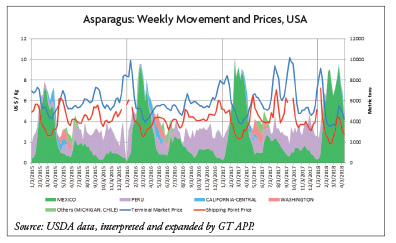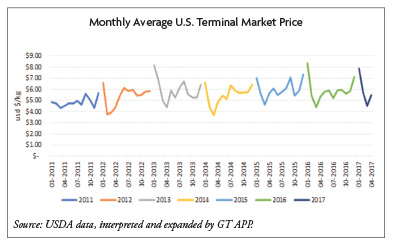National shipping point prices during other months of the year fluctuate, to about $4 per kilogram, with wholesale terminal market prices at about $6 per kilogram.
The rest of the year the market is supplied by Peru and Mexico, and Chile to a lesser degree. Mexico produces year-round but its production decreases to a quarter of its peak supply when not in high season (February and March). March harvests average 30,000 metric tons, though 2017’s harvest reached 34,000 metric tons, its highest production since 2015, after warm temperatures and rain altered January and February markets.




Peruvian exporters obtain higher prices, the highest of the year, because they are almost alone in the market for some weeks, just after Central California and Mexico’s high season ends.
Peruvian asparagus producers take advantage of this window of opportunity, orienting harvests to these weeks, creating a short seasonal monopoly and securing much higher prices at $4 to $6 per kilogram at shipping point (shipping point prices are considered the equivalent of full container-load prices, while terminal market prices are wholesale prices or per box, and already include seller margin and logistics costs).
The Peruvian window lasts from August to January; Peru, Chile, Washington, and Michigan produce from April to June filling the market that Mexico and Central California leave, obtaining higher prices. If the Mexican season is delayed due to cold weather, Peruvians can supply the U.S. market for these extra days at very high prices. This is possible because it only takes one day to produce the spears that are sent to the market by plane.



